News
Interview with Keith Bowers
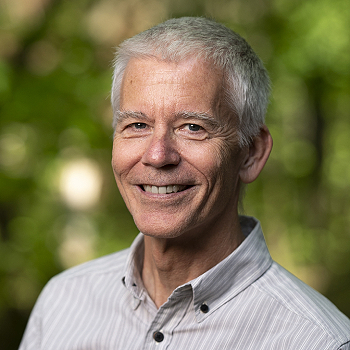 Keith Bowers, FASLA / Larry Canner
Keith Bowers, FASLA / Larry Canner
You have said the dangers of the biodiversity crisis are equal to or even greater than the climate crisis. Can you elaborate?
If we stop emitting carbon dioxide, climate change could be stopped or reversed. But if we lose species, they're gone forever.
We've seen species extinction and the degradation of ecosystems proceed at a rapid pace. We're losing species at a rate of about anywhere from 100 to 1,000 times faster than the background rate, based on previous extinctions. Addressing climate change will remove one threat to biodiversity, but it won't stop its decline. If we fix climate change tomorrow, we still are dealing with a massive degradation of nature and biodiversity.
Nature is infinitely more complex than a molecule of carbon. We're coming up with ways to deal with carbon. But nature is more complex, so we're still learning a great deal.
When we lose ecosystems or genetic diversity, that impacts our ability to survive as a human species, not to mention all the other more-than-human species that inhabit the planet with us. The food we eat, the air we breathe, the water we drink, the medicines we use are all directly related to nature. If we lose nature, we're going to severely impact all the things that keep us alive and thriving.
While we look to the sky trying to figure out what to do with climate change, nature is being pulled out right from under us.
Last year, world leaders met at the Convention on Biological Diversity and committed to new global biodiversity targets, including protecting and restoring 30% of terrestrial, coastal, and ocean ecosystems by 2030. Of the 23 targets, which are you focused on?
Conserving and managing at least 30 percent of the world's lands, inland waters, and coastal areas is something we're directly involved in and we take to heart every day.
The targets include four overarching goals, including: the "integrity and connectivity and resilience of
all ecosystems are maintained, enhanced, or restored, sustainably
increasing the area of natural ecosystems by 2050." This is where landscape architects can have the greatest impact. We're all involved and can help make sure this goal is met.
The 23 targets can be put into four categories. One is on-the-ground action targets. The other is policy initiatives. The third is financing and capacity building. The fourth deals with inclusion and equity.
At Biohabitats, we're really focused on the on-the-ground actions. That's conserving habitat and species. It's restoring ecosystems, managing invasive species, and adapting and mitigating to climate change. We deal with these on all our projects. But you can't think of any of these global targets independently. They're all connected to one another.
Our work also falls into the inclusion and equity batch of targets. We think about Indigenous peoples, communities of color, and underserved communities and make sure these communities not only participate in the work we do, but have the ability to make decisions, deciding what's going to happen in their neighborhood, communities, and on their land with their consent.
How can landscape architects better design projects to achieve the 2030 biodiversity targets? What are the top three actions landscape architects can take to increase biodiversity in their work?
First, protect and conserve the biodiversity within your sphere of influence.
Second, restore biodiversity, which can take many forms. Look at how the site is connected to the rest of the landscape from a landscape ecology perspective. Seek to understand how nutrients cycle and flow through the site, how water interacts with the site, how species move across the site or inhabit the site, and how that's all connected to the regional landscape. It's really hard to increase biodiversity on a site if we don't understand these connections and relationships.
Third, once you have an idea of what you're going to protect and conserve, develop ideas and ways to restore and enhance biodiversity. This can take the form of many different strategies and measures.
Landscape architects have a tremendous influence and impact on the way biodiversity is protected, conserved, restored, and enhanced.
Biodiverse landscapes provide a range of ecosystem services, including carbon sequestration. But with growing climate impacts like wildfires, landscapes can also become major sources of emissions. Biohabitats analyzed the carbon storage capacity of a fire-prone landscape for the City of Boulder, Colorado. What did you learn?
We were commissioned by the City of Boulder to look at whether their annual carbon sequestration in their open spaces and mountain parks would help them offset the carbon they emit as a city. We inventoried the carbon stock, and annual flux of their landscape, and projected what the loss may be based on fire or another land disturbances, and what the landscape's potential is in terms of sequestering carbon under a changing climate and with the application of nature-based solutions.
We looked at over 36,000 acres. We found these lands had a really large existing carbon stock. 2.8 million cubic tons of carbon were already being stored in those landscapes.
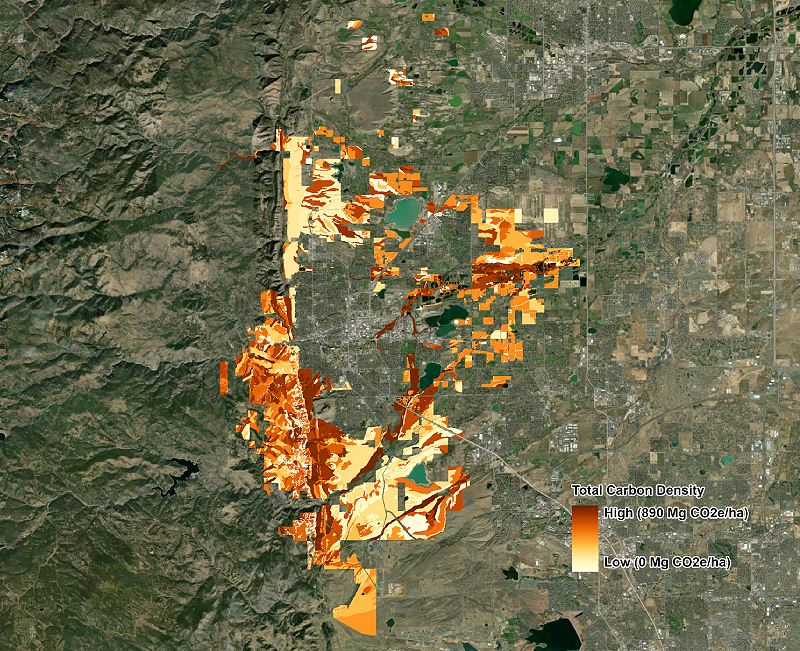 Map illustrates areas with the greatest carbon density based on soils and landcover. Biohabitats. City of Boulder Open Space and Mountain Parks. Sustainability Solutions Group / Biohabitats
Map illustrates areas with the greatest carbon density based on soils and landcover. Biohabitats. City of Boulder Open Space and Mountain Parks. Sustainability Solutions Group / Biohabitats The grasslands had the greatest existing carbon storage, mostly in their soils. Wetlands actually had a greater carbon density per acre, but they cover relatively small areas. While the forest and grasslands can store significant amount of carbon in the landscape, our modeling of fire scenarios found that they were also a potential source of carbon emissions due to the risk of loss under certain scenarios.
We found that nature-based solutions could help draw down carbon and reduce loss. For example, prescribed burning can be used to improve landscape resilience. Because when fire-evolved ecosystems aren't burned, the fires burn with more intensity and typically burn the soil as well. With frequent fires, you get less intensity, and they produce less carbon emissions.
This fell in line with other studies around the world. It also emphasized why developing or tilling greenfields is destructive in terms of carbon emissions. Protecting and conserving wild lands and parks is really important in reducing carbon emissions.
To the untrained eye, some of your firm's projects look natural, like nothing has been done. Your beautiful project at Teaneck Creek Park in Bergen County, New Jersey, restored 46 acres of freshwater wetlands. Big Marsh Park on the South Side of Chicago restored a dumping ground and treats wastewater, but looks pristine. Is that one of your measures of design success -- for your work to read as nature?
A quick story: We worked on a stream and riparian restoration project in Columbia, Maryland, which sits between Baltimore and Washington, D.C. in the 1990s. A reporter contacted us and said “I want to go out and take some pictures of the site you restored.” We told them where it was, and they went out. We got a call the next day saying they couldn't find it. They were standing exactly at the point where we did the restoration.
With a lot of our restoration work, we hope it blends back into the existing landscape. But it goes a little bit deeper than that. We think about how to restore ecological processes, like food webs, hydrologic or nutrient cycles, ecological succession or disturbance regimes like fire. That's what we focus on, not necessarily what the landscape’s going to look like.
It's really place dependent. Every place has these processes, but they operate at different levels, scales, complexities, and relationships. A long grass prairie, an eastern deciduous forest, or a Gulf Coast tidal wetland are different. We're trying to first understand those processes and design to protect, restore, enhance them.
If we start doing that, then that manifests itself into what the landscape is going to look like; what the plant community is going to look like; how water flows through, over, under the site; how species interact with the landscape; and how the site evolves. We're trying to mimic ecosystem processes within landscapes that are relatively stable and intact. Much like architects or landscape architects use precedent images, we use reference landscapes.
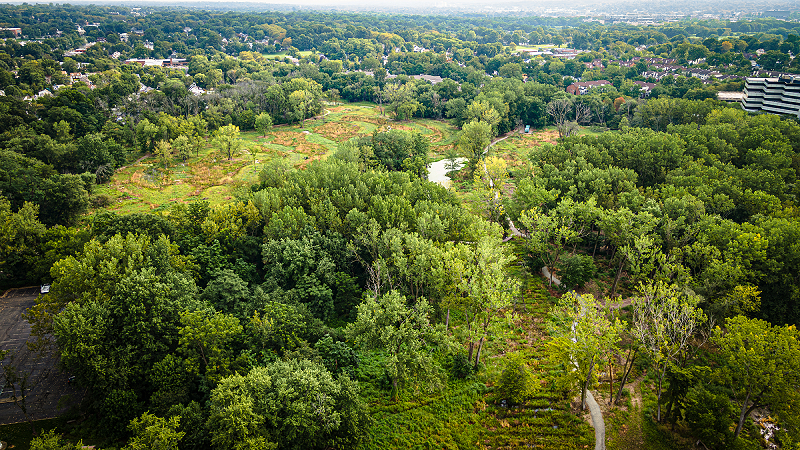 Sand seepage wetlands at Teaneck Creek Park provide stormwater attenuation and water quality filtration while enhancing local biodiversity. Biohabitats. Bergen County Dept. Of Parks. Teaneck Creek Conservancy. Rutgers’ Center for Urban Environmental Sustainability / David Ike Photography
Sand seepage wetlands at Teaneck Creek Park provide stormwater attenuation and water quality filtration while enhancing local biodiversity. Biohabitats. Bergen County Dept. Of Parks. Teaneck Creek Conservancy. Rutgers’ Center for Urban Environmental Sustainability / David Ike Photography 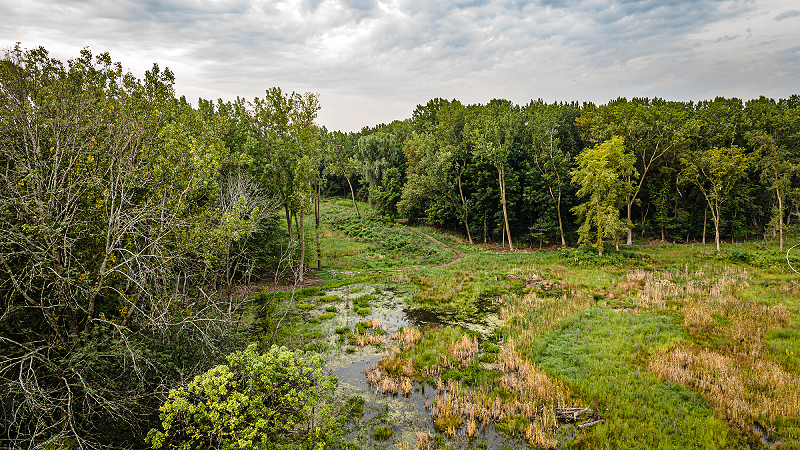 Teaneck Creek Park. Biohabitats. Bergen County Dept. Of Parks. Teaneck Creek Conservancy. Rutgers’ Center for Urban Environmental Sustainability / David Ike Photography
Teaneck Creek Park. Biohabitats. Bergen County Dept. Of Parks. Teaneck Creek Conservancy. Rutgers’ Center for Urban Environmental Sustainability / David Ike PhotographyFor us, there's an inherent beauty in natural systems. We're trying to create the building blocks that allow natural systems to regenerate. For a landscape to be sustainable, robust ecological processes need to be in place. Otherwise, the system is going to fall apart.
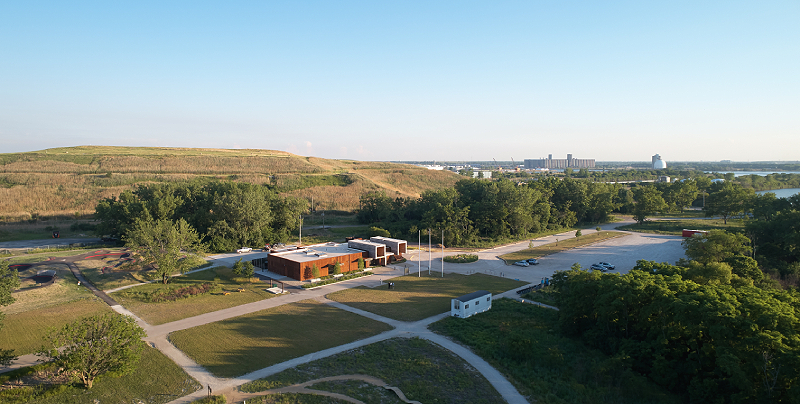 The Ford Calumet Environmental Center in Big Marsh Park, designed by Valerio Dewalt Train, is home to Chicago's first decentralized wastewater treatment and disposal system. The system, designed by Biohabitats, includes constructed wetlands, which demonstrate environmental stewardship while serving and improving access to nature. Biohabitats. Chicago Park District
Valero Dewalt Train Associates. DbHMS Engineering. Jacobs/Ryan Associates / Tom Harris
The Ford Calumet Environmental Center in Big Marsh Park, designed by Valerio Dewalt Train, is home to Chicago's first decentralized wastewater treatment and disposal system. The system, designed by Biohabitats, includes constructed wetlands, which demonstrate environmental stewardship while serving and improving access to nature. Biohabitats. Chicago Park District
Valero Dewalt Train Associates. DbHMS Engineering. Jacobs/Ryan Associates / Tom Harris We also work in highly disturbed landscapes that are disconnected from natural processes -- for example, brownfields or high-density urban areas. While our goal is to restore the full suite of ecosystem processes and functions, many times we are quite limited in what we can do.
Scientists are calling these novel ecosystems. It's the idea that we can use these reference landscapes as an analog but knowing that we'll never be able to replicate many of the ecological processes that sustain these landscapes. What can we restore that has a semblance of ecological integrity and provides value to the life of that landscape? That's where we begin.
It goes back to our tagline: “We're in the business of restoring the future, not the past.” We can't go back to the past because there have been so many changes to our landscapes, ecosystems, and planetary systems. We need to look forward.
Your firm works with the Army Corps of Engineers, which has a large contingent of landscape architects. What do you think that the Corps needs to do to fully realize its vision of Engineering with Nature?
We've been working with the Corps of Engineers for almost 30 years. I will give a shout-out to Dr. Todd Bridges, who, with his cohort of researchers and other practitioners, developed the Engineering with Nature initiative while he was at the U.S Army Engineer Research and Development Center (ERDC). Todd is now with a team of researchers at the University of Georgia, working in collaboration with the Corps and others to advance the idea of nature-based solutions for infrastructure projects all over the world.
In 2022, the ERDC contributed to The White House roadmap for accelerating nature-based solutions. This roadmap lays out five recommendations that the Corps and all federal agencies need to do. For the Corps, this will require Congress to change Corps policies, reallocate funding, and shift priorities. It's not that the Corps is necessarily trying to make things more difficult or put-up roadblocks. Literally, they can't do many of the changes we want to see or do until Congress gives them authorization. It's up to all of us to advocate to our representatives in Congress to make these changes happen.
For example, the Corps has specific guidelines on how they evaluate project alternatives, which give overwhelming preference to damage reduction and business loss reductions. These are worthy benefits, but for the most part they completely ignore ecological and social benefits. It's hard for the Corps to justify the use of nature-based solutions if the benefit is not quantifiable.
But just this past February, the Corps released a final rule to change that policy. If this rule is adopted, the Corps will be able to develop project alternatives that maximize environmental and public benefits. This allows both quantitative and qualitative data to be used in determining the highest benefit to lowest cost ratio. This alone will accelerate the application of nature-based solutions and aesthetic and context sensitive design considerations in infrastructure projects throughout the country. This could be a game-changer.
Your firm also integrates nature into dense urban environments, like a green street in downtown D.C. How do these small projects provide opportunities to increase biodiversity?
We've been working with the Golden Triangle Business Improvement District in D.C. for several years. We're designing and retrofitting bioretention facilities into the streetscape. Obviously, as landscape architects, we are excited to see bioretention as a stormwater quantity and quality management system being designed and installed all over the world.
The idea of bioretention was developed by Larry Coffman in Prince George's County, Maryland, a suburb just outside of Washington, D.C. in the early 1990s. Biohabitats was fortunate enough to have worked with Larry on that research, the design specifications, and proof of concept for the very first bioretention facilities in the world. So, this is sort of the homecoming for us.
 Stair-stepping bioretention cells provide opportunities to showcase native diversity in the Golden Triangle neighborhood of Washington, DC. Biohabitats. Golden Triangle Business Improvement District. DC Department of Energy & Environment. Triangle Contracting. TCG Property Care. Timmons Group Insight LLC / Biohabitats
Stair-stepping bioretention cells provide opportunities to showcase native diversity in the Golden Triangle neighborhood of Washington, DC. Biohabitats. Golden Triangle Business Improvement District. DC Department of Energy & Environment. Triangle Contracting. TCG Property Care. Timmons Group Insight LLC / BiohabitatsThere are many benefits. They improve water quality by removing pollutants through soil microbes and uptake by plants. They infiltrate stormwater into the ground and help replenish groundwater. They reduce runoff off from impervious surfaces and designed with trees. They help reduce the heat island effect. They also provide micro-habitats for pollinator species and migratory song birds among other species. Bioretention facilities are wonderful ways to benefit nature and biodiversity in urban areas.
Lastly, in 2023, Biohabitats transitioned ownership from being a privately-held company to a perpetual purpose trust, much like Patagonia did. How did you decide this was the best way to achieve your long-term goals for your team and the planet?
Yes, on Earth Day, 2023, Biohabitats sold all its shares to the Biohabitats Purpose Trust (BPT), which is a non-charitable trust with the explicit purpose of "restoring nature, protecting and conserving biodiversity and inspiring love for wild places."
I began looking a different options for ownership transition about seven years ago. I looked at selling Biohabitats to our team members, another firm, or private equity. I also considered an employee stock ownership plan, a co-op, and a variety of hybrid business models. Eventually, I came across the concept of a Perpetual Purpose Trust through a business group I belonged to. The idea of locking in our purpose and mission in perpetuity really appealed to me and our team.
With the BPT, Biohabitats’ purpose, mission, and values are locked in for the next 100 plus years and cannot be bought or sold. Under the BPT, Biohabitats operates as a for-profit company trading as C-corporation, with a Benefit Corporation overlay. We are also B-Corps certified, a JUST company, and 1% for the Planet Member. The profits Biohabitats earns are no longer extracted by shareholders, because the BPT is the only shareholder and doesn’t need profits. Instead, profits get reinvested back into our team members, stakeholders, and nature.
The BPT is governed by a board of trustees within the Trust Earth Stewardship Committee, which is responsible for making sure that Biohabitats is meeting its purpose and objectives. There are five seats on this stewardship committee, and we have designated and legally codified one seat for nature. Nature, represented by a nature guardian, has a seat at the table and more importantly, agency in making sure that Biohabitats is meeting its purpose and objectives. We believe it's the first time in the U.S. that nature has been legally assigned as Trustee. For the wild!
Keith Bowers, FASLA, is a landscape architect, restoration ecologist, and founder of Biohabitats. He is co-chair of the ASLA Biodiversity and Climate Action Committee Subcommittee on Biodiversity and Carbon Drawdown.